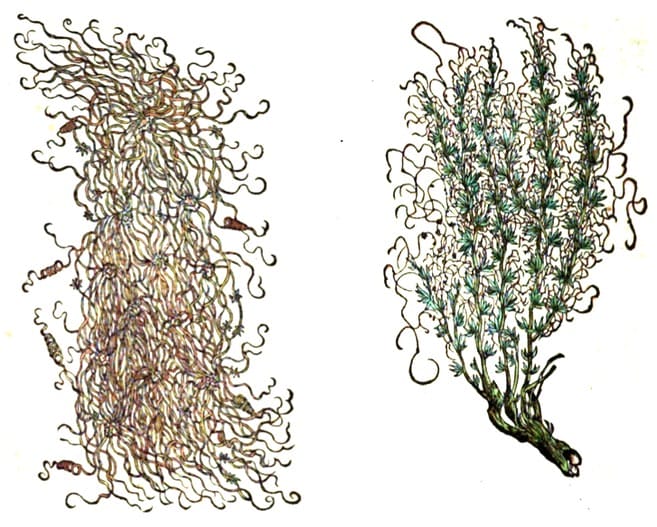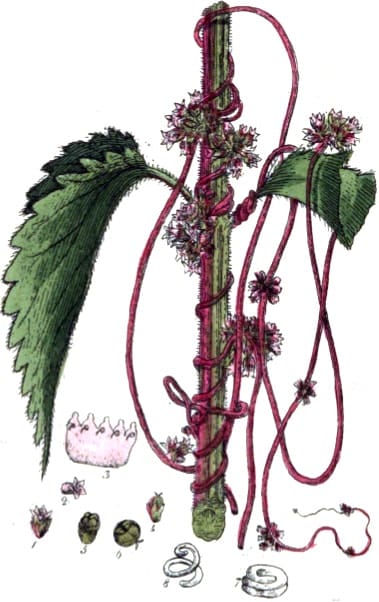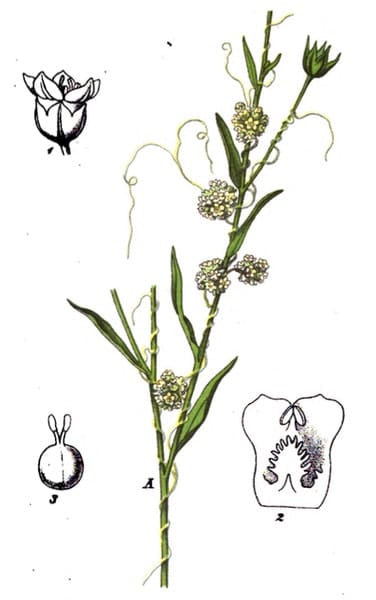Cuscuta Semen, Dodder seed, Tu Si Zi 菟丝子Tu Si Zi (TCM)Kasoos (Unani) Sbrul zhags སྦྲུལ་ཞགས (Tibet) |

|
 Left: Dodder, Cuscuta ; Right: Dodder of Thyme, Epithymum
Left: Dodder, Cuscuta ; Right: Dodder of Thyme, EpithymumKreutterbuch, Matthiolus, 1586

|

|
|
E. europea British Phaenogamous Botany, Baxter, 1834 |
C. vulgaris (syn. C. epilinum) Flora von Deutschland (16), Kohler, 1884 |
Botanical name:
Cuscuta spp.
European is supplied by C. europea, C. epithymum (syn. C. minor), C. vulgaris
Greater or Lesser types, as well as White and Red types were recognised.
It is a parasitic herb on Hops, Nettle and Flax, among others. That of Thyme was regarded as best and was called Epithymum. Schroder said the whole herb in flower was used, chiefly that from Flax.
The Chinese Dodder is C. chinensis (and others)
Parts used:
Seed
Temperature & Taste:
Neutral, Pungent and Sweet
Classification:
N. Tonify Yang
Uses:
1. Tonifies Yin and Yang, Secures the Essence: (TCM, Tibet)
-Impotence, Nocturnal Emission, Premature Ejaculation (TCM)
-Lower Back and Knee Pain (TCM, Tibet)
-Urinary frequency, Vaginal Discharge (TCM, Tibet)
-‘reinforces the Jing (Essence]’ (Ben Cao Gang Mu)
-‘long term use gives a lustrous complexion and rejuvenates the body’. (wine-prepared seed, Su Song)
2. Tonifies Liver and Kidneys, Settles Wind: (TCM, Tibet)
-‘tones the Liver invaded by pathogenic Wind when it is in a deficient condition’. (Ben Cao Gang Mu)
-Dizziness, Tinnitus (TCM, Tibet)
-Poor Vision, Spots in front of the Eyes
-‘Brightens the Eyes’. (Ming Yi Bie Lu)
3. Strengthens the Spleen, Benefits Qi:
-Chronic Diarrhea or Loose stool from deficiency (Spleen, or Spleen and Kidney)
-‘makes the patient feel happy and energetic and enjoy a long life’. (Ming Yi Bie Lu)
-also used for Melancholy as for the herb.
4. Calms the Fetus, Prevents Miscarriage:
-Threatened or Habitual Miscarriage
-Restless Fetus
-Gynecological diseases (Tibet)
Dose:
1. Some Traditional Chinese texts said it was best taken in powders and pills, not decoction. (Tao Hong Jing)
2. Alcohol was said to enhance the effect (either used in its preparation, or as a vehicle).
Decoction: 6–15 grams
Powder: 2–5 grams
Correctives:
1. Tragacanth
2. Chicory
Substitutes:
1. The Barefoot Doctors Manual (Official Para-medical Manual of China) suggests that the herb and seed may be used interchangeably.
Preparations:
1. Stir-fried Tu Si Zi:
The seeds are stir fried until browned, but not burnt. This increases their warmth and enhances their Yang increasing effects.
2. Wine-prepared Cuscuta Tu Si Zi:
According to Chinese classics, the seed is best soaked for 24 hours in wine, then dried and powder.
A more elaborate version soaks 1 cup of seeds in 1 cup of wine, then remove and dry in the sun. Repeat the soaking and drying until all the wine is absorbed, then dry and powder. Take 6 grams as a dose with wine. ‘Long-term use gives one a lustrous complexion and rejuvenates the body. After 10 days of use, the therapeutic effect is obviously seen’. (Su Song)
3. Salt-Prepared Tu Si Zi:
A strong solution of salt is prepared, and about 10% by weight is added to the Dodder, seeds, which are then stir-fried to drying.
This has the effect of leading the seeds to the Kidneys, and is used in some Yang tonic formula. It is also preferred to prevent Miscarriage.
4. Steamed Cuscuta Tu Si Zi:
Soak the seed in wine for 4–5 days. Beat to a paste, then steam and dry. It is then powdered and kept for use.
5. Cuscuta Tu Si Zi Prepared with Polygonatum Huang Jing:
Soak the seed in vinegar for 2 days, then soak in the juice of Polygonatum Huang Jing overnight. The next day, stew the seed in the juice until dry.
Main Combinations:
1. Spermatorrhea, Premature Ejaculation, Lower Back Pain, Cuscuta Tu Si Zi with Eucommia Du Zhong, Cornus Shan Zhu Yu and Velvet Deer Horn
2. Diarrhea or Loose Stool with Poor Appetite, combine Cuscuta Tu Si Zi with Poria Fu Ling, Dioscorea Shan Yao and Codonopsis Dang Shen.
3. Poor or Blurry Vision, Cuscuta Tu Si Zi with Lycium Gou Qi Zi (‘Goji berries’)
4. Menstrual irregularity, breast distention, premenstrual depression, depression from Qi stagnation and Kidney deficiency, Cuscuta Tu Si Zi with Paeonia Bai Shao, Dang Gui, Dioscorea Shan Yao, Bupleurum Chai Hu, Schizonopeta Jing Jie (as in Ding Jing Tang)
5. Threatened Miscarriage:
i. from Kidney deficiency Cuscuta Tu Si Zi with Loranthus Sang Ji Sheng (Mulberry Mistletoe) and Eucommia Du Zhong (as in An Tai Yin)
ii. from Qi and Blood deficiency, Cuscuta Tu Si Zi with Dang Gui, Astragalus Huang Qi
iii. from Kidney deficiency, Cuscuta Tu Si Zi with Dipsacus Xu Duan, Eucommia Du Zhong, Dang Gui, Lycium Gou Qi Zi, Atractylodes Bai Zhu (as in Bu Shen Gu Chong Wan)
6. Impotence, Cuscuta Tu Si Zi with Withania, Asparagus root, Pyrethrum, Nutmeg, Salep (Orchis), Saffron (Unani)
7. Sciatica, Dodder seed was combined with Sage (West)
Major Formulas:
Troches for Daily Fever (Galen)
Tu Si Zi Wan
You Gui Wan
Shou Tai Wan
An Tai Yin
Bao Chan Wu You Fang
Bu Shen Gu Chong Wan
Ding Jing Tang
Qi Bao Mei Ran Dan
Cautions:
Not used in Deficient Heat; full doses may cause Nausea.
Main Preparations used:
Distilled Water of the whole Plant
|
‘Kushooth is the Arabic name for the Dodders, and from it have been derived tho Greek [?] and Latin Cuscuta of mediaeval writers. An Arabian poet says:— ” He is like the Kashooth; for he has neither root, leaves, fragrance, shade or fruit.” In the Indian bazars the name is applied to the fruit of a species of Cuscuta, imported from Persia, and also called Tukm-i-kasus; it is mixed with the small oblong leaves and spines of the plant upon which it has grown, and the flowers and portions of the stem may often be found. The seeds are four in number, light brown, convex on one side, concave on the other, and |
enclosed in a nearly globular capsule about the size of a radish seed. The taste is bitter. Mir Muhammad Husain identifies this drug with the Amal-bel, Akus-bel, or Amarlata of India, and describes it as yellow, growing on thorns and other shrubs, and as having a very small, whitish flower, and seeds rather smaller than radish seeds, nearly round, and of a reddish yellow colour. Its proper ties are described as much the same as those of Aftimun. The plant may be either C. hyalina, Roth., C. chinensis, Lam., or C. planijlora, Tenore; possibly several species are collected. In India C. reflexa, Roxb., is sometimes used; it is a larger plant, and has larger fruit than the imported article.” (Pharmacographia Indica, Dymock, 1891) |
–Effect of the semen extract of Cuscuta chinensis on inflammatory responses in LPS-stimulated BV-2 microglia.
–Antinociceptive and anti-inflammatory activities of Cuscuta chinensis seeds in mice.
PREPARATION:
–Comparative Investigation Between Raw and Stir-Frying Processed Cuscutae Semen Based on HPLC Fingerprints Coupled With Chemometric Methods.
–An integrated approach to uncover quality markers of stir-baking Semen Cuscuta with salt solution preventing recurrent spontaneous abortion based on chemical and metabolomic profiling.
–16S rDNA sequencing combined with metabolomics profiling with multi-index scoring method reveals the mechanism of salt-processed Semen Cuscuta in Bushen Antai mixture on kidney yang deficiency syndrome.
–Pharmacokinetic/Pharmacodynamic Study of Salt-Processed product of Cuscutae Semen with Hepatoprotective Effects.
–Pharmacokinetic/Pharmacodynamic Study of Salt-Processed product of Cuscutae Semen with Hepatoprotective Effects.
–Tracing anti-osteoporosis components from raw and salt-processed semen of Cuscuta chinensis by employing a biochemometrics strategy that integrates ultrasonic-assisted extraction, quantitation, efficacy assessment in zebrafish, and grey relationship analysis.
–Comparative Studies on Chemical Contents and Effect in Kidney-Yang Deficiency Rats of Salt-Processed Product and Wine-Processed Product of Cuscutae Semen.
–An Established HPLC-MS/MS Method for Evaluation of the Influence of Salt Processing on Pharmacokinetics of Six Compounds in Cuscutae Semen.
–The Difference of Chemical Components and Biological Activities of the Crude Products and the Salt-Processed Product from Semen Cuscutae.
–[Optimization of processing technology for semen cuscuta by uniform and regression analysis].
HEPATOPROTECTIVE:
–Ultra-performance liquid chromatography quadrupole time-of-flight mass spectrometry-based plasma metabolomics study of hepatoprotective effect of cuscutae semen on CCl4 -induced liver injury model of rats.
–Pharmacokinetic/Pharmacodynamic Study of Salt-Processed product of Cuscutae Semen with Hepatoprotective Effects.
–Spectrum-Effect Relationships Between High-Performance Liquid Chromatography Fingerprints and Hepatoprotective Activities of Cuscutae Semen.
–Protective effects of Cuscutae semen against dimethylnitrosamine-induced acute liver injury in Sprague-Dawley rats.
MALE INFERTILITY:
–The effect of semen cuscutae flavonoid on Sertoli cells and blood-testis barrier in male infertility: integrating network pharmacology and experimental verification.
–Semen Cuscutae-Fructus Lycii improves spermatogenic dysfunction by repairing the blood-testis barrier in rats according to in silico and in vitro methods.
SPERMATOGENIC:
–A combination of Semen Cuscutae and Fructus Lycii improves testicular cell proliferation and inhibits their apoptosis in rats with spermatogenic dysfunction by regulating the SCF/c-kit–PI3K–Bcl-2 pathway.
OLIGOASTHENOZOOSPERMIA:
–In vitro and in vivo investigation of the therapeutic mechanism of Lycium Chinense and Cuscutae Semen on oligoasthenozoospermia.
–An Integrated Analysis of Network Pharmacology, Molecular Docking, and Experiment Validation to Explore the New Candidate Active Component and Mechanism of Cuscutae Semen-Mori Fructus Coupled-Herbs in Treating Oligoasthenozoospermia.
YANG DEFICIENCY:
–16S rDNA sequencing combined with metabolomics profiling with multi-index scoring method reveals the mechanism of salt-processed Semen Cuscuta in Bushen Antai mixture on kidney yang deficiency syndrome.
–Metabolomics analysis of Semen Cuscutae protection of kidney deficient model rats using ultra high-performance liquid chromatography-quadrupole time-of-flight Mass Spectrometry.
–Comparative Studies on Chemical Contents and Effect in Kidney-Yang Deficiency Rats of Salt-Processed Product and Wine-Processed Product of Cuscutae Semen.
–Purification, characterization and biological effect of reversing the kidney-yang deficiency of polysaccharides from semen cuscutae.
–The total flavones from Semen cuscutae reverse the reduction of testosterone level and the expression of androgen receptor gene in kidney-yang deficient mice.
ESTROGENIC EFFECT:
[Evaluation on phytoestrogen effects of ten kinds of Chinese medicine including flos carthami].
PREMATURE OVARIAN FAILURE:
–LIPUS combined with TFSC alleviates premature ovarian failure by promoting autophagy and inhibiting apoptosis.
POLYCISTIC OVARIAN SYNDROME (PCOS):
–An Analysis of the Clinical Medication Rules of Traditional Chinese Medicine for Polycystic Ovary Syndrome Based on Data Mining.
THIN ENDOMETRIUM:
–Network Pharmacology and Molecular Docking Approach to Reveal the Immunotherapeutic Mechanism of Cuscutae Semen in Treating Thin Endometrium.
THREATENED MISCARRIAGE:
–An integrated approach to uncover quality markers of stir-baking Semen Cuscuta with salt solution preventing recurrent spontaneous abortion based on chemical and metabolomic profiling.
–Systems Pharmacology-Based Research on the Mechanism of Tusizi-Sangjisheng Herb Pair in the Treatment of Threatened Abortion.
OSTEOPOROSIS:
–Anti-osteoporosis effect of Semen Cuscutae in ovariectomized mice through inhibition of bone resorption by osteoclasts.
–Tracing anti-osteoporosis components from raw and salt-processed semen of Cuscuta chinensis by employing a biochemometrics strategy that integrates ultrasonic-assisted extraction, quantitation, efficacy assessment in zebrafish, and grey relationship analysis.
–The preventive effect of Cuscutae Semen polysaccharide on bone loss in the ovariectomized rat model.
–A Network Pharmacology Approach to Estimate the Active Ingredients and Potential Targets of Cuscutae semen in the Treatment of Osteoporosis.
DEPRESSION:
–Cuscutae semen alleviates CUS-induced depression-like behaviors in mice via the gut microbiota-neuroinflammation axis.
NEUROPROTECTIVE:
–Neuroprotective effects of cuscutae semen in a mouse model of Parkinson’s disease.
MEMORY DEFICIT:
–Cuscuta chinensis and C. campestris Attenuate Scopolamine-Induced Memory Deficit and Oxidative Damage in Mice.
ALZHEMIER’S DISEASE:
–Cuscutae Japonicae Semen Ameliorates Memory Dysfunction by Rescuing Synaptic Damage in Alzheimer’s Disease Models.
PARKINSON’S DISEASE:
–Neuroprotective effects of cuscutae semen in a mouse model of Parkinson’s disease.
CANCER:
PROSTATE:
–Assessing the Mechanism of Action of “Fructus Ligustri Lucidi-Cuscutae Semen” in Prostate Cancer Treatment Using Network Pharmacology and Molecular Docking.
